Report on Task Assignments: Leadership, Quality and Risk
VerifiedAdded on 2022/09/06
|29
|5952
|41
Report
AI Summary
This comprehensive report delves into various aspects of leadership and management, focusing on quality management theories, change models, and risk analysis. It begins by examining five quality management and continuous improvement theories, including Deming's theory, EFQM framework, Corby's theory, Joseph Juran's theory, and Ishikawa's theory. The report then explores Kotter's 8-Step change model, the diffusion of innovation theory, and the purpose and standards of ISO 9000. It also discusses cost-benefit analysis, the concept of a learning organization, shared vision, and team learning. Furthermore, the report addresses sustainability practices in Australian workplaces and provides a detailed analysis of risk management, including the factors that contribute to a successful risk management system and the seven steps in the risk management process as outlined in AS/NZS ISO 31000:2009. The report also includes a case study of Woodhouse Recruitment Company, evaluating its performance and offering recommendations for improvement.
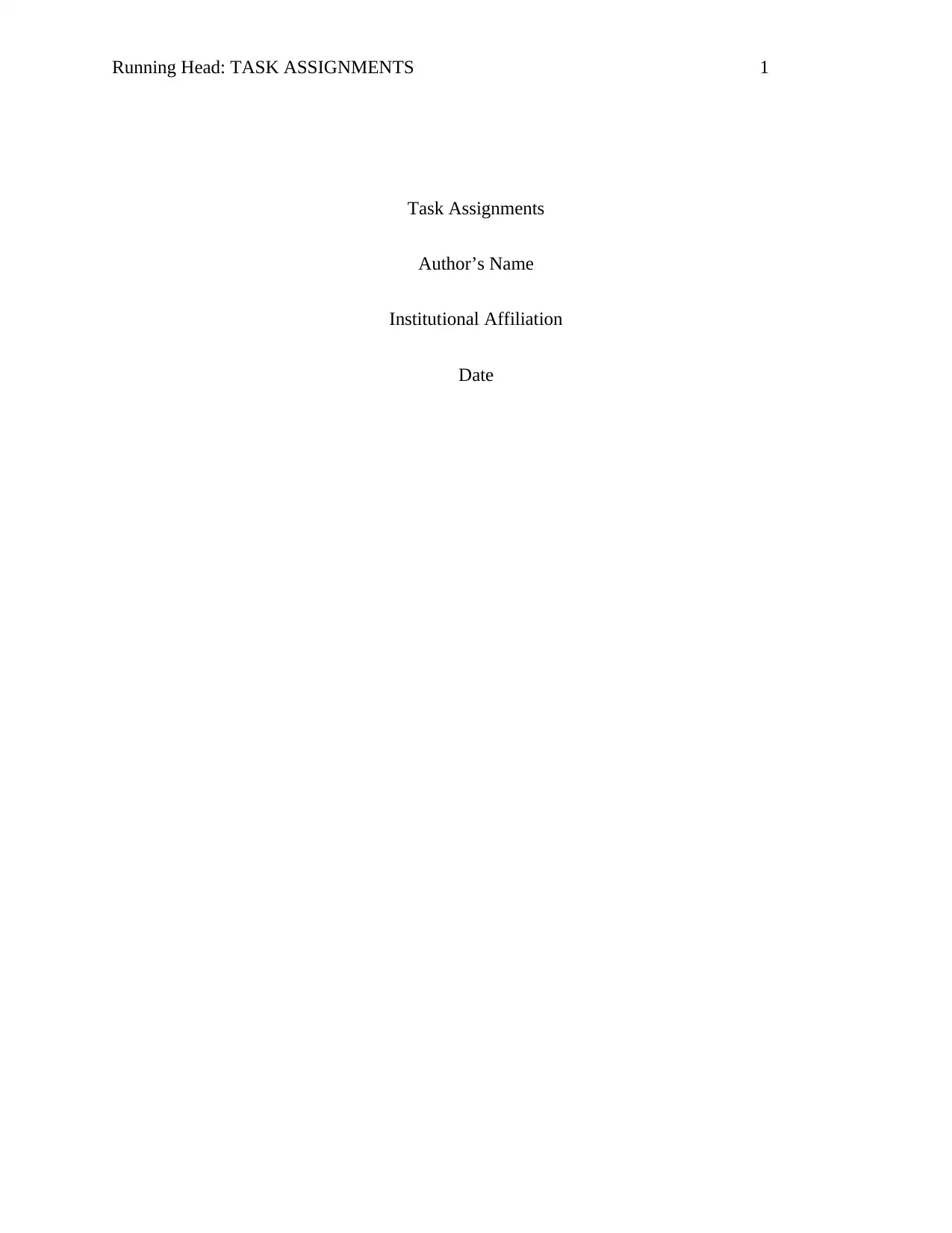
Running Head: TASK ASSIGNMENTS 1
Task Assignments
Author’s Name
Institutional Affiliation
Date
Task Assignments
Author’s Name
Institutional Affiliation
Date
Paraphrase This Document
Need a fresh take? Get an instant paraphrase of this document with our AI Paraphraser
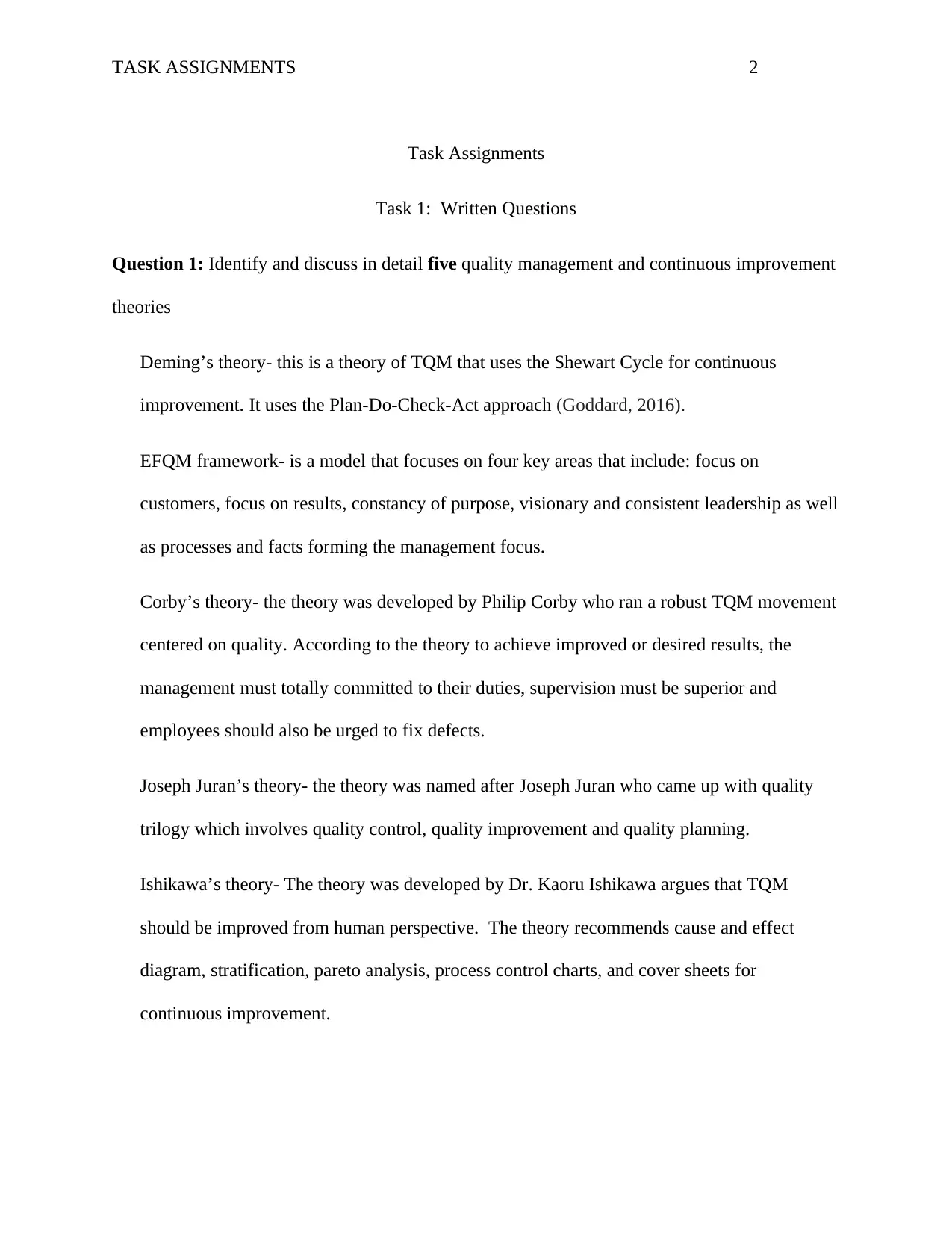
TASK ASSIGNMENTS 2
Task Assignments
Task 1: Written Questions
Question 1: Identify and discuss in detail five quality management and continuous improvement
theories
Deming’s theory- this is a theory of TQM that uses the Shewart Cycle for continuous
improvement. It uses the Plan-Do-Check-Act approach (Goddard, 2016).
EFQM framework- is a model that focuses on four key areas that include: focus on
customers, focus on results, constancy of purpose, visionary and consistent leadership as well
as processes and facts forming the management focus.
Corby’s theory- the theory was developed by Philip Corby who ran a robust TQM movement
centered on quality. According to the theory to achieve improved or desired results, the
management must totally committed to their duties, supervision must be superior and
employees should also be urged to fix defects.
Joseph Juran’s theory- the theory was named after Joseph Juran who came up with quality
trilogy which involves quality control, quality improvement and quality planning.
Ishikawa’s theory- The theory was developed by Dr. Kaoru Ishikawa argues that TQM
should be improved from human perspective. The theory recommends cause and effect
diagram, stratification, pareto analysis, process control charts, and cover sheets for
continuous improvement.
Task Assignments
Task 1: Written Questions
Question 1: Identify and discuss in detail five quality management and continuous improvement
theories
Deming’s theory- this is a theory of TQM that uses the Shewart Cycle for continuous
improvement. It uses the Plan-Do-Check-Act approach (Goddard, 2016).
EFQM framework- is a model that focuses on four key areas that include: focus on
customers, focus on results, constancy of purpose, visionary and consistent leadership as well
as processes and facts forming the management focus.
Corby’s theory- the theory was developed by Philip Corby who ran a robust TQM movement
centered on quality. According to the theory to achieve improved or desired results, the
management must totally committed to their duties, supervision must be superior and
employees should also be urged to fix defects.
Joseph Juran’s theory- the theory was named after Joseph Juran who came up with quality
trilogy which involves quality control, quality improvement and quality planning.
Ishikawa’s theory- The theory was developed by Dr. Kaoru Ishikawa argues that TQM
should be improved from human perspective. The theory recommends cause and effect
diagram, stratification, pareto analysis, process control charts, and cover sheets for
continuous improvement.
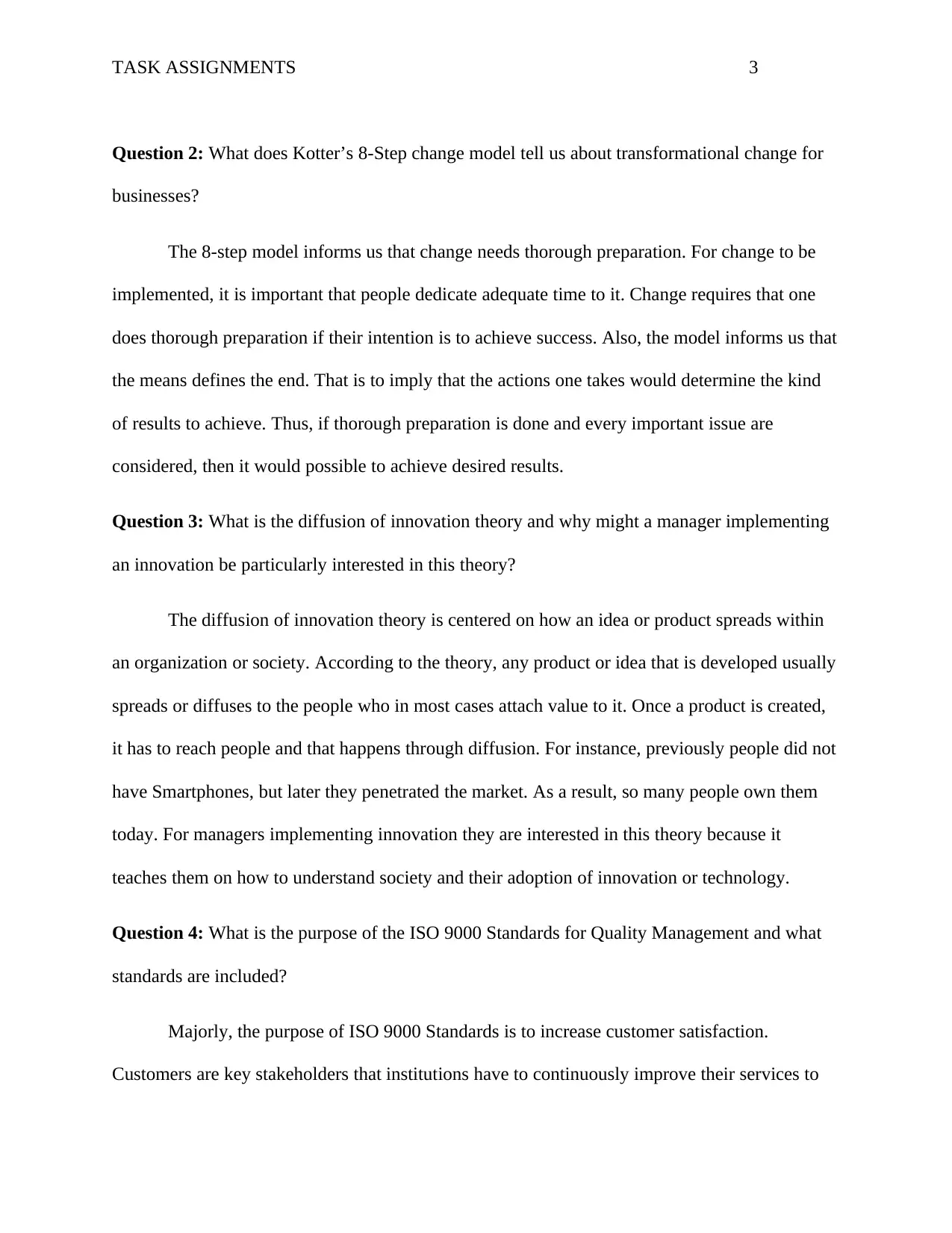
TASK ASSIGNMENTS 3
Question 2: What does Kotter’s 8-Step change model tell us about transformational change for
businesses?
The 8-step model informs us that change needs thorough preparation. For change to be
implemented, it is important that people dedicate adequate time to it. Change requires that one
does thorough preparation if their intention is to achieve success. Also, the model informs us that
the means defines the end. That is to imply that the actions one takes would determine the kind
of results to achieve. Thus, if thorough preparation is done and every important issue are
considered, then it would possible to achieve desired results.
Question 3: What is the diffusion of innovation theory and why might a manager implementing
an innovation be particularly interested in this theory?
The diffusion of innovation theory is centered on how an idea or product spreads within
an organization or society. According to the theory, any product or idea that is developed usually
spreads or diffuses to the people who in most cases attach value to it. Once a product is created,
it has to reach people and that happens through diffusion. For instance, previously people did not
have Smartphones, but later they penetrated the market. As a result, so many people own them
today. For managers implementing innovation they are interested in this theory because it
teaches them on how to understand society and their adoption of innovation or technology.
Question 4: What is the purpose of the ISO 9000 Standards for Quality Management and what
standards are included?
Majorly, the purpose of ISO 9000 Standards is to increase customer satisfaction.
Customers are key stakeholders that institutions have to continuously improve their services to
Question 2: What does Kotter’s 8-Step change model tell us about transformational change for
businesses?
The 8-step model informs us that change needs thorough preparation. For change to be
implemented, it is important that people dedicate adequate time to it. Change requires that one
does thorough preparation if their intention is to achieve success. Also, the model informs us that
the means defines the end. That is to imply that the actions one takes would determine the kind
of results to achieve. Thus, if thorough preparation is done and every important issue are
considered, then it would possible to achieve desired results.
Question 3: What is the diffusion of innovation theory and why might a manager implementing
an innovation be particularly interested in this theory?
The diffusion of innovation theory is centered on how an idea or product spreads within
an organization or society. According to the theory, any product or idea that is developed usually
spreads or diffuses to the people who in most cases attach value to it. Once a product is created,
it has to reach people and that happens through diffusion. For instance, previously people did not
have Smartphones, but later they penetrated the market. As a result, so many people own them
today. For managers implementing innovation they are interested in this theory because it
teaches them on how to understand society and their adoption of innovation or technology.
Question 4: What is the purpose of the ISO 9000 Standards for Quality Management and what
standards are included?
Majorly, the purpose of ISO 9000 Standards is to increase customer satisfaction.
Customers are key stakeholders that institutions have to continuously improve their services to
⊘ This is a preview!⊘
Do you want full access?
Subscribe today to unlock all pages.

Trusted by 1+ million students worldwide
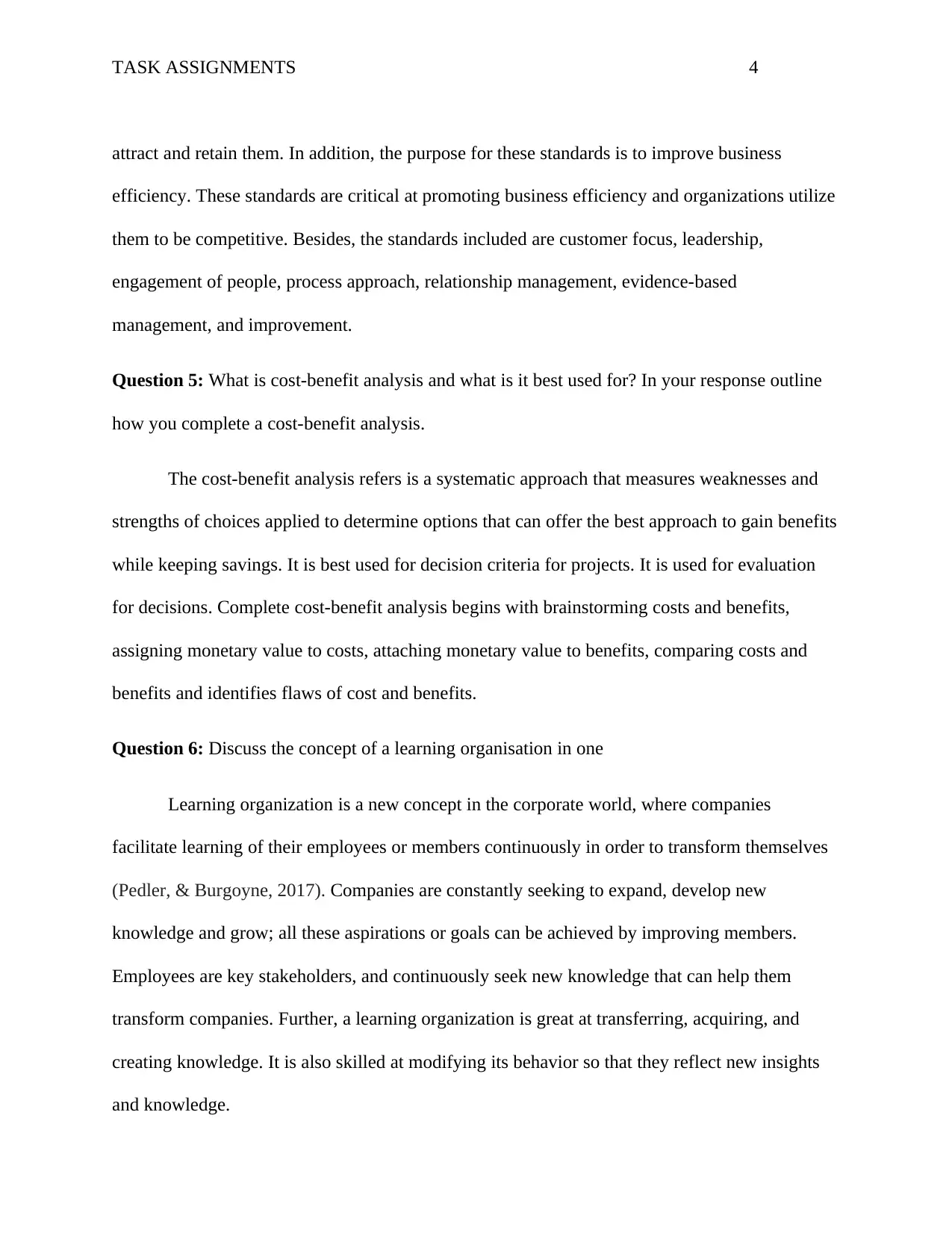
TASK ASSIGNMENTS 4
attract and retain them. In addition, the purpose for these standards is to improve business
efficiency. These standards are critical at promoting business efficiency and organizations utilize
them to be competitive. Besides, the standards included are customer focus, leadership,
engagement of people, process approach, relationship management, evidence-based
management, and improvement.
Question 5: What is cost-benefit analysis and what is it best used for? In your response outline
how you complete a cost-benefit analysis.
The cost-benefit analysis refers is a systematic approach that measures weaknesses and
strengths of choices applied to determine options that can offer the best approach to gain benefits
while keeping savings. It is best used for decision criteria for projects. It is used for evaluation
for decisions. Complete cost-benefit analysis begins with brainstorming costs and benefits,
assigning monetary value to costs, attaching monetary value to benefits, comparing costs and
benefits and identifies flaws of cost and benefits.
Question 6: Discuss the concept of a learning organisation in one
Learning organization is a new concept in the corporate world, where companies
facilitate learning of their employees or members continuously in order to transform themselves
(Pedler, & Burgoyne, 2017). Companies are constantly seeking to expand, develop new
knowledge and grow; all these aspirations or goals can be achieved by improving members.
Employees are key stakeholders, and continuously seek new knowledge that can help them
transform companies. Further, a learning organization is great at transferring, acquiring, and
creating knowledge. It is also skilled at modifying its behavior so that they reflect new insights
and knowledge.
attract and retain them. In addition, the purpose for these standards is to improve business
efficiency. These standards are critical at promoting business efficiency and organizations utilize
them to be competitive. Besides, the standards included are customer focus, leadership,
engagement of people, process approach, relationship management, evidence-based
management, and improvement.
Question 5: What is cost-benefit analysis and what is it best used for? In your response outline
how you complete a cost-benefit analysis.
The cost-benefit analysis refers is a systematic approach that measures weaknesses and
strengths of choices applied to determine options that can offer the best approach to gain benefits
while keeping savings. It is best used for decision criteria for projects. It is used for evaluation
for decisions. Complete cost-benefit analysis begins with brainstorming costs and benefits,
assigning monetary value to costs, attaching monetary value to benefits, comparing costs and
benefits and identifies flaws of cost and benefits.
Question 6: Discuss the concept of a learning organisation in one
Learning organization is a new concept in the corporate world, where companies
facilitate learning of their employees or members continuously in order to transform themselves
(Pedler, & Burgoyne, 2017). Companies are constantly seeking to expand, develop new
knowledge and grow; all these aspirations or goals can be achieved by improving members.
Employees are key stakeholders, and continuously seek new knowledge that can help them
transform companies. Further, a learning organization is great at transferring, acquiring, and
creating knowledge. It is also skilled at modifying its behavior so that they reflect new insights
and knowledge.
Paraphrase This Document
Need a fresh take? Get an instant paraphrase of this document with our AI Paraphraser
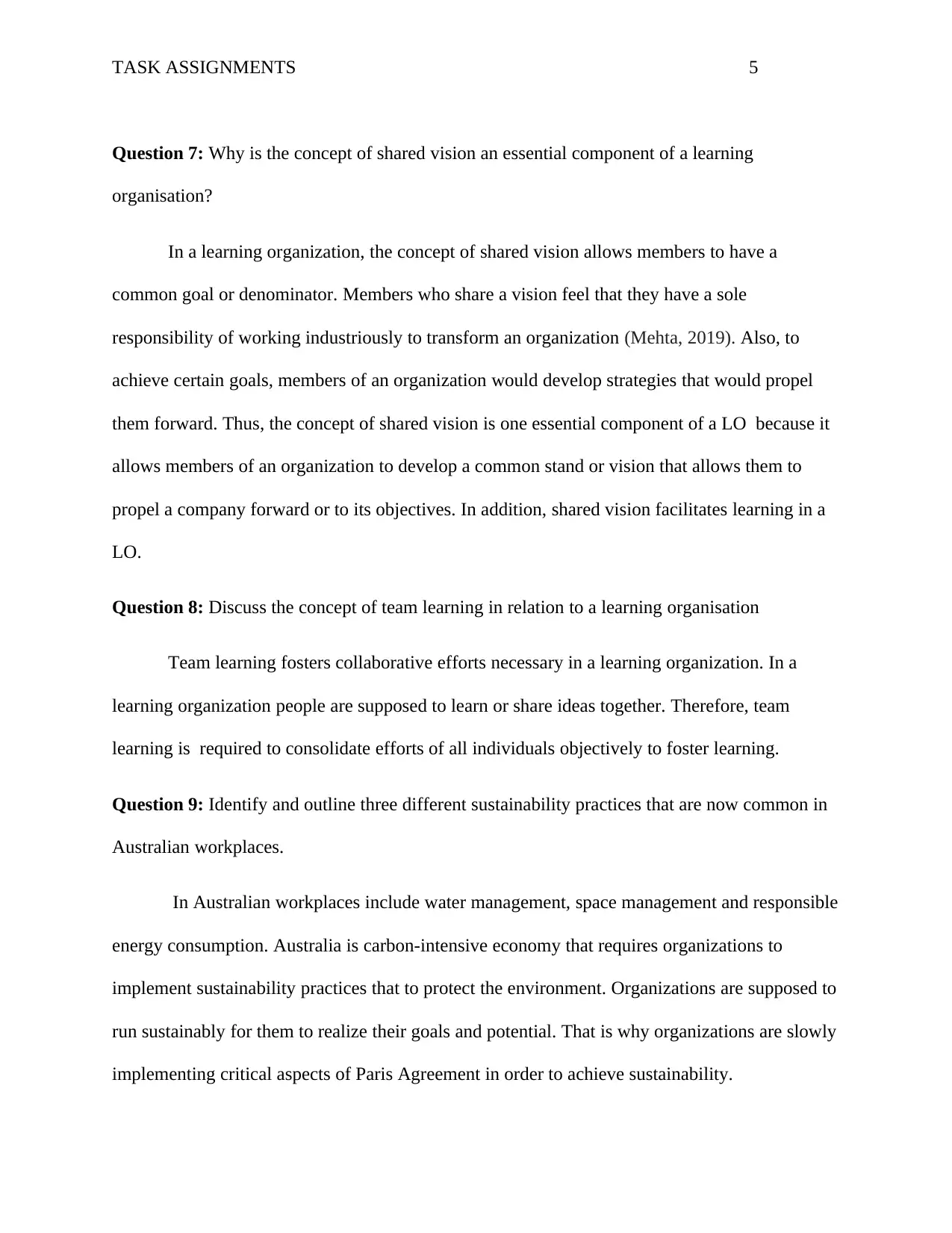
TASK ASSIGNMENTS 5
Question 7: Why is the concept of shared vision an essential component of a learning
organisation?
In a learning organization, the concept of shared vision allows members to have a
common goal or denominator. Members who share a vision feel that they have a sole
responsibility of working industriously to transform an organization (Mehta, 2019). Also, to
achieve certain goals, members of an organization would develop strategies that would propel
them forward. Thus, the concept of shared vision is one essential component of a LO because it
allows members of an organization to develop a common stand or vision that allows them to
propel a company forward or to its objectives. In addition, shared vision facilitates learning in a
LO.
Question 8: Discuss the concept of team learning in relation to a learning organisation
Team learning fosters collaborative efforts necessary in a learning organization. In a
learning organization people are supposed to learn or share ideas together. Therefore, team
learning is required to consolidate efforts of all individuals objectively to foster learning.
Question 9: Identify and outline three different sustainability practices that are now common in
Australian workplaces.
In Australian workplaces include water management, space management and responsible
energy consumption. Australia is carbon-intensive economy that requires organizations to
implement sustainability practices that to protect the environment. Organizations are supposed to
run sustainably for them to realize their goals and potential. That is why organizations are slowly
implementing critical aspects of Paris Agreement in order to achieve sustainability.
Question 7: Why is the concept of shared vision an essential component of a learning
organisation?
In a learning organization, the concept of shared vision allows members to have a
common goal or denominator. Members who share a vision feel that they have a sole
responsibility of working industriously to transform an organization (Mehta, 2019). Also, to
achieve certain goals, members of an organization would develop strategies that would propel
them forward. Thus, the concept of shared vision is one essential component of a LO because it
allows members of an organization to develop a common stand or vision that allows them to
propel a company forward or to its objectives. In addition, shared vision facilitates learning in a
LO.
Question 8: Discuss the concept of team learning in relation to a learning organisation
Team learning fosters collaborative efforts necessary in a learning organization. In a
learning organization people are supposed to learn or share ideas together. Therefore, team
learning is required to consolidate efforts of all individuals objectively to foster learning.
Question 9: Identify and outline three different sustainability practices that are now common in
Australian workplaces.
In Australian workplaces include water management, space management and responsible
energy consumption. Australia is carbon-intensive economy that requires organizations to
implement sustainability practices that to protect the environment. Organizations are supposed to
run sustainably for them to realize their goals and potential. That is why organizations are slowly
implementing critical aspects of Paris Agreement in order to achieve sustainability.
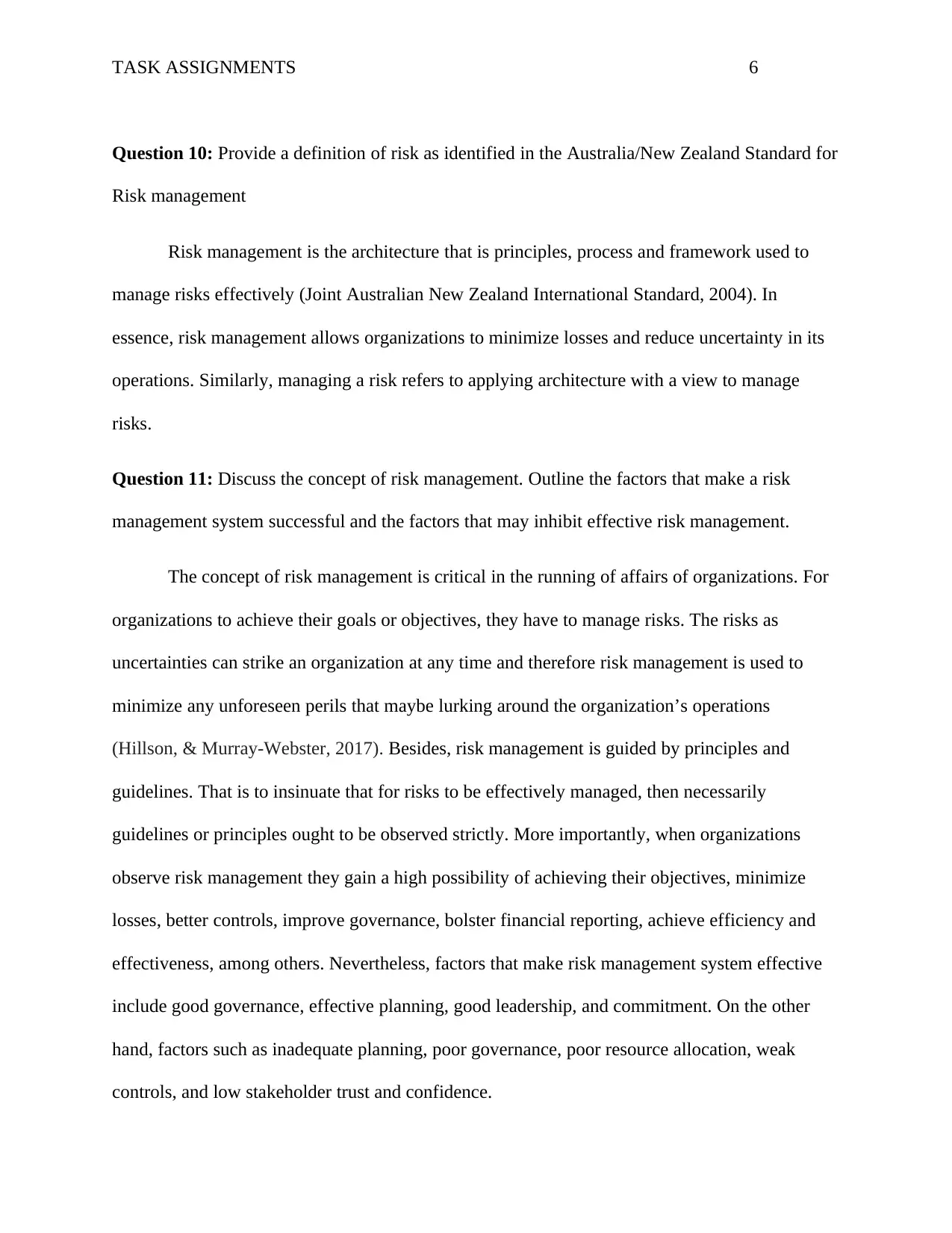
TASK ASSIGNMENTS 6
Question 10: Provide a definition of risk as identified in the Australia/New Zealand Standard for
Risk management
Risk management is the architecture that is principles, process and framework used to
manage risks effectively (Joint Australian New Zealand International Standard, 2004). In
essence, risk management allows organizations to minimize losses and reduce uncertainty in its
operations. Similarly, managing a risk refers to applying architecture with a view to manage
risks.
Question 11: Discuss the concept of risk management. Outline the factors that make a risk
management system successful and the factors that may inhibit effective risk management.
The concept of risk management is critical in the running of affairs of organizations. For
organizations to achieve their goals or objectives, they have to manage risks. The risks as
uncertainties can strike an organization at any time and therefore risk management is used to
minimize any unforeseen perils that maybe lurking around the organization’s operations
(Hillson, & Murray-Webster, 2017). Besides, risk management is guided by principles and
guidelines. That is to insinuate that for risks to be effectively managed, then necessarily
guidelines or principles ought to be observed strictly. More importantly, when organizations
observe risk management they gain a high possibility of achieving their objectives, minimize
losses, better controls, improve governance, bolster financial reporting, achieve efficiency and
effectiveness, among others. Nevertheless, factors that make risk management system effective
include good governance, effective planning, good leadership, and commitment. On the other
hand, factors such as inadequate planning, poor governance, poor resource allocation, weak
controls, and low stakeholder trust and confidence.
Question 10: Provide a definition of risk as identified in the Australia/New Zealand Standard for
Risk management
Risk management is the architecture that is principles, process and framework used to
manage risks effectively (Joint Australian New Zealand International Standard, 2004). In
essence, risk management allows organizations to minimize losses and reduce uncertainty in its
operations. Similarly, managing a risk refers to applying architecture with a view to manage
risks.
Question 11: Discuss the concept of risk management. Outline the factors that make a risk
management system successful and the factors that may inhibit effective risk management.
The concept of risk management is critical in the running of affairs of organizations. For
organizations to achieve their goals or objectives, they have to manage risks. The risks as
uncertainties can strike an organization at any time and therefore risk management is used to
minimize any unforeseen perils that maybe lurking around the organization’s operations
(Hillson, & Murray-Webster, 2017). Besides, risk management is guided by principles and
guidelines. That is to insinuate that for risks to be effectively managed, then necessarily
guidelines or principles ought to be observed strictly. More importantly, when organizations
observe risk management they gain a high possibility of achieving their objectives, minimize
losses, better controls, improve governance, bolster financial reporting, achieve efficiency and
effectiveness, among others. Nevertheless, factors that make risk management system effective
include good governance, effective planning, good leadership, and commitment. On the other
hand, factors such as inadequate planning, poor governance, poor resource allocation, weak
controls, and low stakeholder trust and confidence.
⊘ This is a preview!⊘
Do you want full access?
Subscribe today to unlock all pages.

Trusted by 1+ million students worldwide
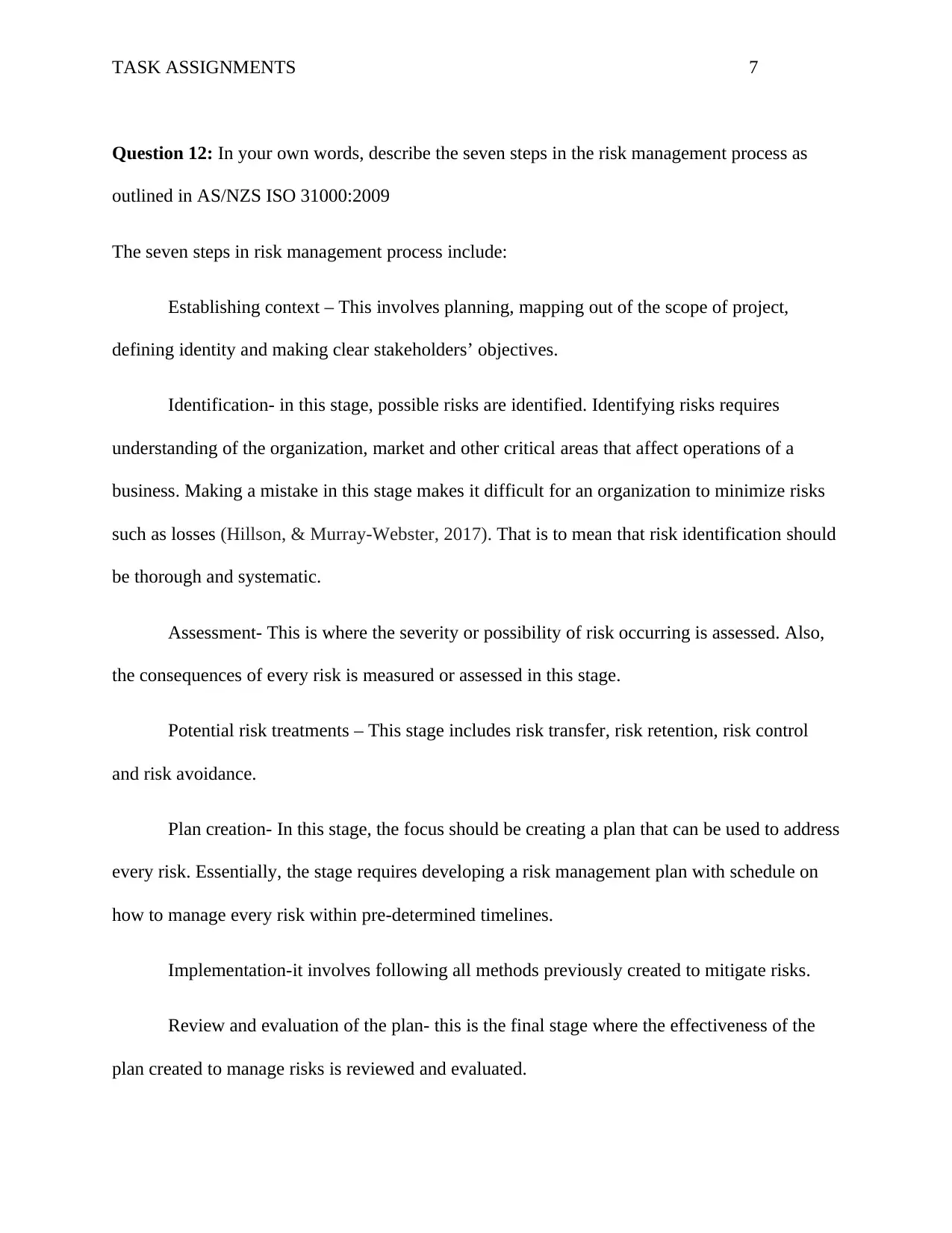
TASK ASSIGNMENTS 7
Question 12: In your own words, describe the seven steps in the risk management process as
outlined in AS/NZS ISO 31000:2009
The seven steps in risk management process include:
Establishing context – This involves planning, mapping out of the scope of project,
defining identity and making clear stakeholders’ objectives.
Identification- in this stage, possible risks are identified. Identifying risks requires
understanding of the organization, market and other critical areas that affect operations of a
business. Making a mistake in this stage makes it difficult for an organization to minimize risks
such as losses (Hillson, & Murray-Webster, 2017). That is to mean that risk identification should
be thorough and systematic.
Assessment- This is where the severity or possibility of risk occurring is assessed. Also,
the consequences of every risk is measured or assessed in this stage.
Potential risk treatments – This stage includes risk transfer, risk retention, risk control
and risk avoidance.
Plan creation- In this stage, the focus should be creating a plan that can be used to address
every risk. Essentially, the stage requires developing a risk management plan with schedule on
how to manage every risk within pre-determined timelines.
Implementation-it involves following all methods previously created to mitigate risks.
Review and evaluation of the plan- this is the final stage where the effectiveness of the
plan created to manage risks is reviewed and evaluated.
Question 12: In your own words, describe the seven steps in the risk management process as
outlined in AS/NZS ISO 31000:2009
The seven steps in risk management process include:
Establishing context – This involves planning, mapping out of the scope of project,
defining identity and making clear stakeholders’ objectives.
Identification- in this stage, possible risks are identified. Identifying risks requires
understanding of the organization, market and other critical areas that affect operations of a
business. Making a mistake in this stage makes it difficult for an organization to minimize risks
such as losses (Hillson, & Murray-Webster, 2017). That is to mean that risk identification should
be thorough and systematic.
Assessment- This is where the severity or possibility of risk occurring is assessed. Also,
the consequences of every risk is measured or assessed in this stage.
Potential risk treatments – This stage includes risk transfer, risk retention, risk control
and risk avoidance.
Plan creation- In this stage, the focus should be creating a plan that can be used to address
every risk. Essentially, the stage requires developing a risk management plan with schedule on
how to manage every risk within pre-determined timelines.
Implementation-it involves following all methods previously created to mitigate risks.
Review and evaluation of the plan- this is the final stage where the effectiveness of the
plan created to manage risks is reviewed and evaluated.
Paraphrase This Document
Need a fresh take? Get an instant paraphrase of this document with our AI Paraphraser
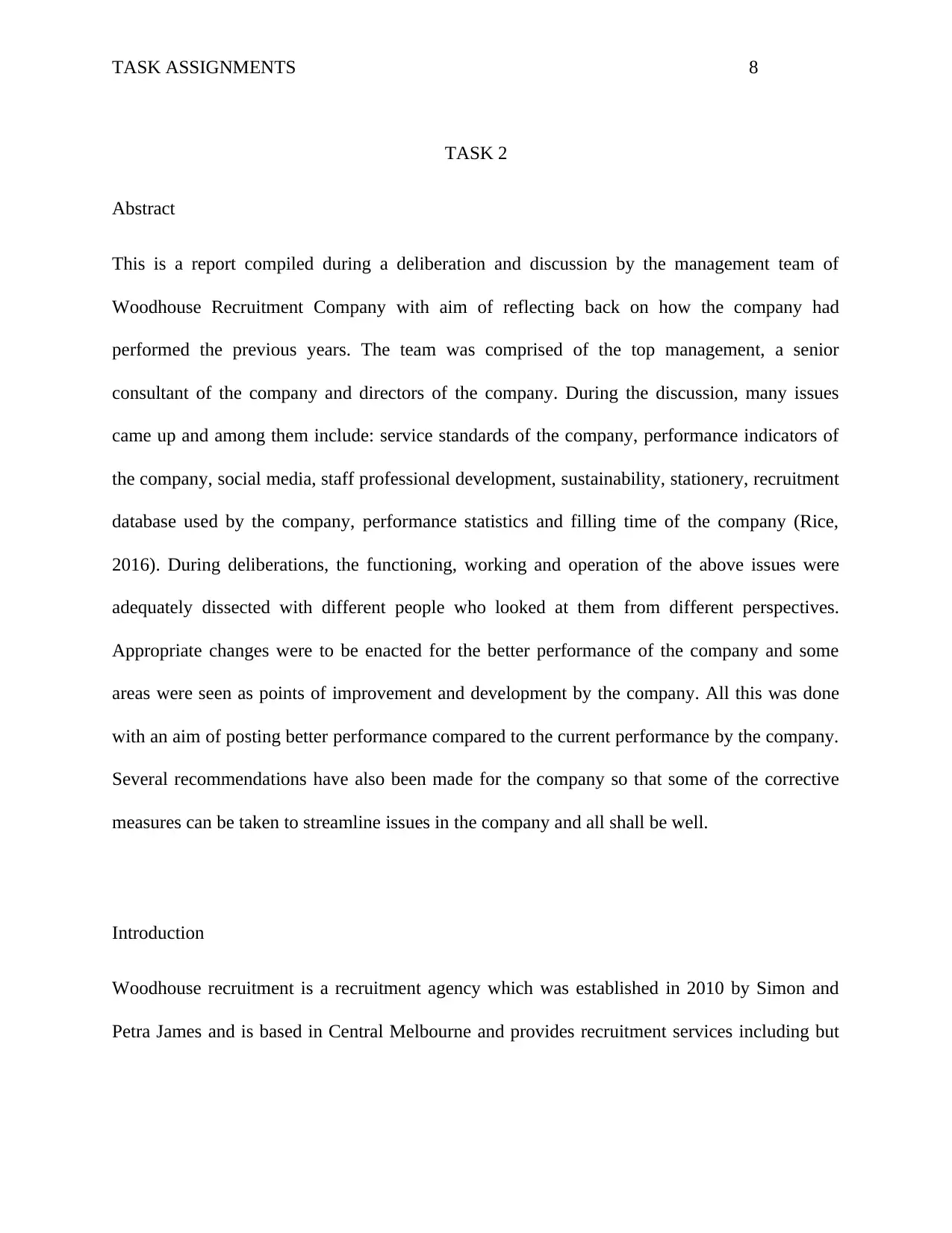
TASK ASSIGNMENTS 8
TASK 2
Abstract
This is a report compiled during a deliberation and discussion by the management team of
Woodhouse Recruitment Company with aim of reflecting back on how the company had
performed the previous years. The team was comprised of the top management, a senior
consultant of the company and directors of the company. During the discussion, many issues
came up and among them include: service standards of the company, performance indicators of
the company, social media, staff professional development, sustainability, stationery, recruitment
database used by the company, performance statistics and filling time of the company (Rice,
2016). During deliberations, the functioning, working and operation of the above issues were
adequately dissected with different people who looked at them from different perspectives.
Appropriate changes were to be enacted for the better performance of the company and some
areas were seen as points of improvement and development by the company. All this was done
with an aim of posting better performance compared to the current performance by the company.
Several recommendations have also been made for the company so that some of the corrective
measures can be taken to streamline issues in the company and all shall be well.
Introduction
Woodhouse recruitment is a recruitment agency which was established in 2010 by Simon and
Petra James and is based in Central Melbourne and provides recruitment services including but
TASK 2
Abstract
This is a report compiled during a deliberation and discussion by the management team of
Woodhouse Recruitment Company with aim of reflecting back on how the company had
performed the previous years. The team was comprised of the top management, a senior
consultant of the company and directors of the company. During the discussion, many issues
came up and among them include: service standards of the company, performance indicators of
the company, social media, staff professional development, sustainability, stationery, recruitment
database used by the company, performance statistics and filling time of the company (Rice,
2016). During deliberations, the functioning, working and operation of the above issues were
adequately dissected with different people who looked at them from different perspectives.
Appropriate changes were to be enacted for the better performance of the company and some
areas were seen as points of improvement and development by the company. All this was done
with an aim of posting better performance compared to the current performance by the company.
Several recommendations have also been made for the company so that some of the corrective
measures can be taken to streamline issues in the company and all shall be well.
Introduction
Woodhouse recruitment is a recruitment agency which was established in 2010 by Simon and
Petra James and is based in Central Melbourne and provides recruitment services including but
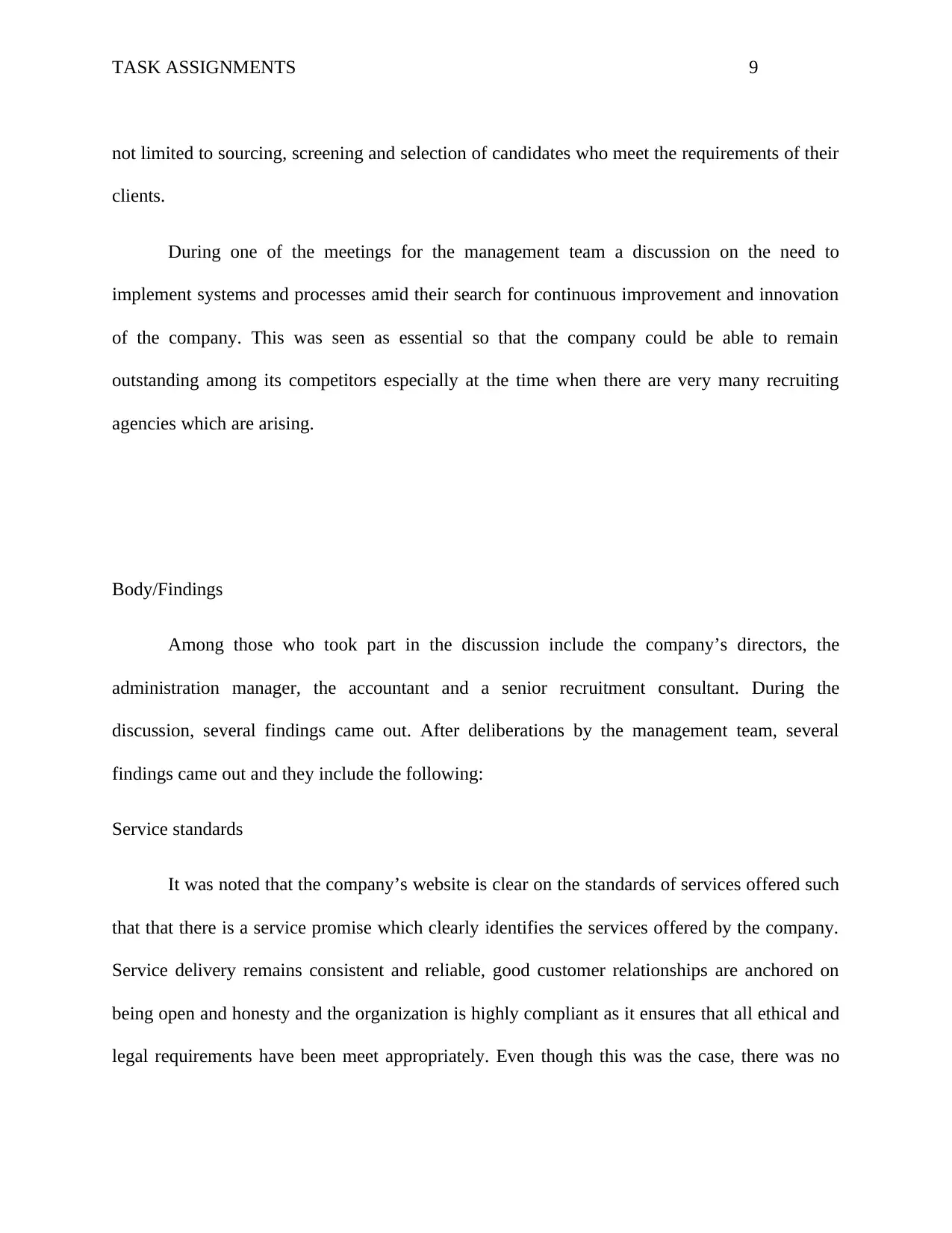
TASK ASSIGNMENTS 9
not limited to sourcing, screening and selection of candidates who meet the requirements of their
clients.
During one of the meetings for the management team a discussion on the need to
implement systems and processes amid their search for continuous improvement and innovation
of the company. This was seen as essential so that the company could be able to remain
outstanding among its competitors especially at the time when there are very many recruiting
agencies which are arising.
Body/Findings
Among those who took part in the discussion include the company’s directors, the
administration manager, the accountant and a senior recruitment consultant. During the
discussion, several findings came out. After deliberations by the management team, several
findings came out and they include the following:
Service standards
It was noted that the company’s website is clear on the standards of services offered such
that that there is a service promise which clearly identifies the services offered by the company.
Service delivery remains consistent and reliable, good customer relationships are anchored on
being open and honesty and the organization is highly compliant as it ensures that all ethical and
legal requirements have been meet appropriately. Even though this was the case, there was no
not limited to sourcing, screening and selection of candidates who meet the requirements of their
clients.
During one of the meetings for the management team a discussion on the need to
implement systems and processes amid their search for continuous improvement and innovation
of the company. This was seen as essential so that the company could be able to remain
outstanding among its competitors especially at the time when there are very many recruiting
agencies which are arising.
Body/Findings
Among those who took part in the discussion include the company’s directors, the
administration manager, the accountant and a senior recruitment consultant. During the
discussion, several findings came out. After deliberations by the management team, several
findings came out and they include the following:
Service standards
It was noted that the company’s website is clear on the standards of services offered such
that that there is a service promise which clearly identifies the services offered by the company.
Service delivery remains consistent and reliable, good customer relationships are anchored on
being open and honesty and the organization is highly compliant as it ensures that all ethical and
legal requirements have been meet appropriately. Even though this was the case, there was no
⊘ This is a preview!⊘
Do you want full access?
Subscribe today to unlock all pages.

Trusted by 1+ million students worldwide
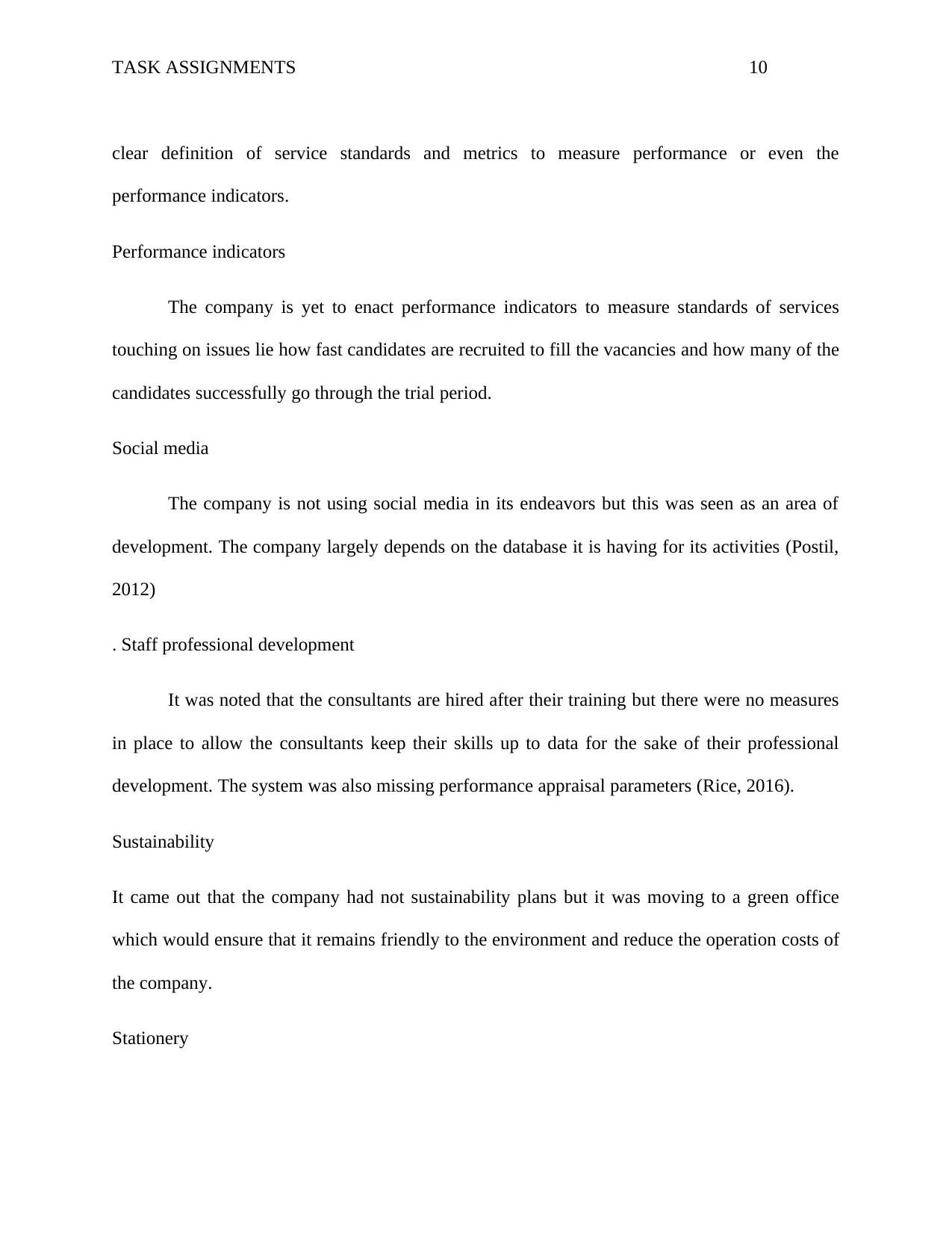
TASK ASSIGNMENTS 10
clear definition of service standards and metrics to measure performance or even the
performance indicators.
Performance indicators
The company is yet to enact performance indicators to measure standards of services
touching on issues lie how fast candidates are recruited to fill the vacancies and how many of the
candidates successfully go through the trial period.
Social media
The company is not using social media in its endeavors but this was seen as an area of
development. The company largely depends on the database it is having for its activities (Postil,
2012)
. Staff professional development
It was noted that the consultants are hired after their training but there were no measures
in place to allow the consultants keep their skills up to data for the sake of their professional
development. The system was also missing performance appraisal parameters (Rice, 2016).
Sustainability
It came out that the company had not sustainability plans but it was moving to a green office
which would ensure that it remains friendly to the environment and reduce the operation costs of
the company.
Stationery
clear definition of service standards and metrics to measure performance or even the
performance indicators.
Performance indicators
The company is yet to enact performance indicators to measure standards of services
touching on issues lie how fast candidates are recruited to fill the vacancies and how many of the
candidates successfully go through the trial period.
Social media
The company is not using social media in its endeavors but this was seen as an area of
development. The company largely depends on the database it is having for its activities (Postil,
2012)
. Staff professional development
It was noted that the consultants are hired after their training but there were no measures
in place to allow the consultants keep their skills up to data for the sake of their professional
development. The system was also missing performance appraisal parameters (Rice, 2016).
Sustainability
It came out that the company had not sustainability plans but it was moving to a green office
which would ensure that it remains friendly to the environment and reduce the operation costs of
the company.
Stationery
Paraphrase This Document
Need a fresh take? Get an instant paraphrase of this document with our AI Paraphraser
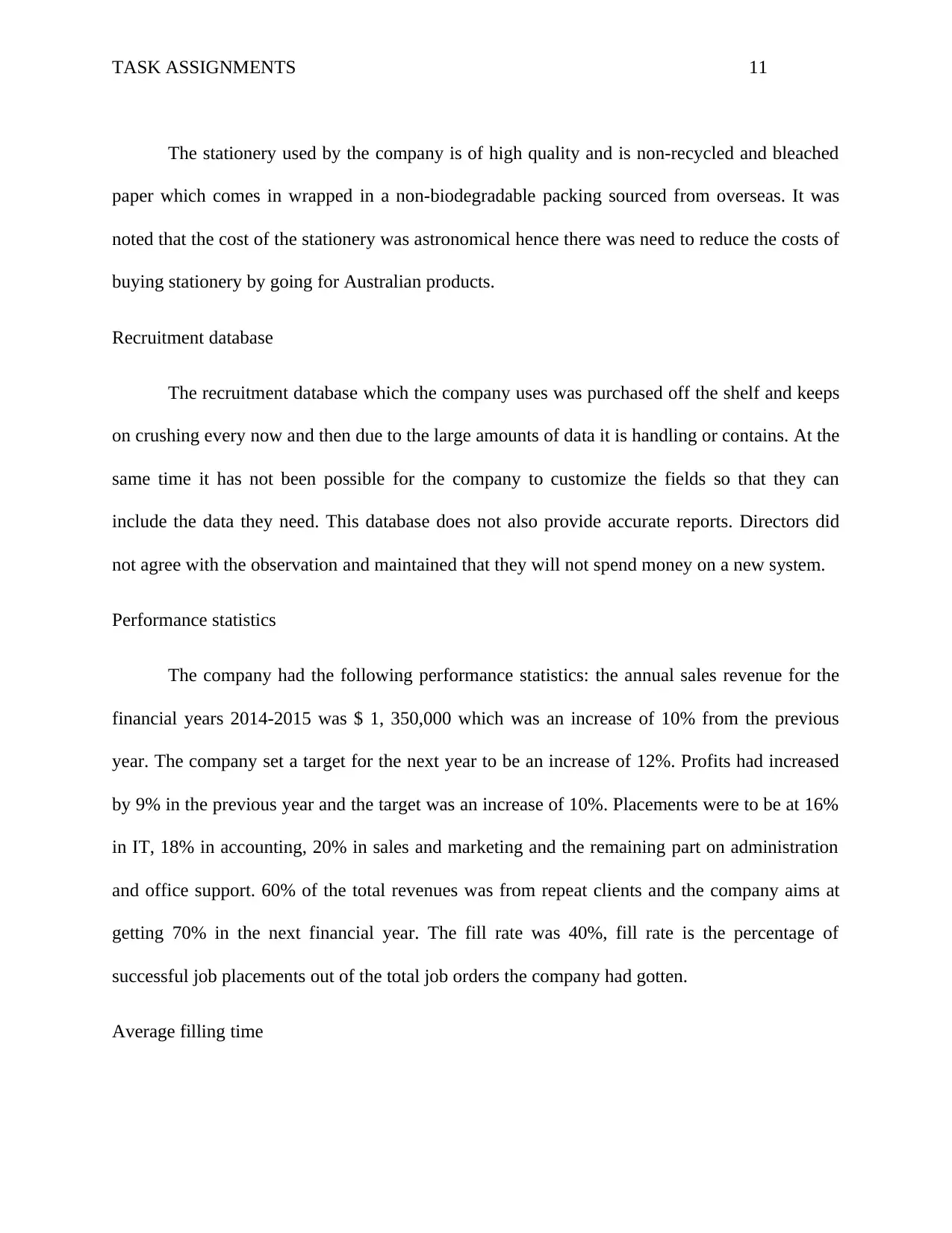
TASK ASSIGNMENTS 11
The stationery used by the company is of high quality and is non-recycled and bleached
paper which comes in wrapped in a non-biodegradable packing sourced from overseas. It was
noted that the cost of the stationery was astronomical hence there was need to reduce the costs of
buying stationery by going for Australian products.
Recruitment database
The recruitment database which the company uses was purchased off the shelf and keeps
on crushing every now and then due to the large amounts of data it is handling or contains. At the
same time it has not been possible for the company to customize the fields so that they can
include the data they need. This database does not also provide accurate reports. Directors did
not agree with the observation and maintained that they will not spend money on a new system.
Performance statistics
The company had the following performance statistics: the annual sales revenue for the
financial years 2014-2015 was $ 1, 350,000 which was an increase of 10% from the previous
year. The company set a target for the next year to be an increase of 12%. Profits had increased
by 9% in the previous year and the target was an increase of 10%. Placements were to be at 16%
in IT, 18% in accounting, 20% in sales and marketing and the remaining part on administration
and office support. 60% of the total revenues was from repeat clients and the company aims at
getting 70% in the next financial year. The fill rate was 40%, fill rate is the percentage of
successful job placements out of the total job orders the company had gotten.
Average filling time
The stationery used by the company is of high quality and is non-recycled and bleached
paper which comes in wrapped in a non-biodegradable packing sourced from overseas. It was
noted that the cost of the stationery was astronomical hence there was need to reduce the costs of
buying stationery by going for Australian products.
Recruitment database
The recruitment database which the company uses was purchased off the shelf and keeps
on crushing every now and then due to the large amounts of data it is handling or contains. At the
same time it has not been possible for the company to customize the fields so that they can
include the data they need. This database does not also provide accurate reports. Directors did
not agree with the observation and maintained that they will not spend money on a new system.
Performance statistics
The company had the following performance statistics: the annual sales revenue for the
financial years 2014-2015 was $ 1, 350,000 which was an increase of 10% from the previous
year. The company set a target for the next year to be an increase of 12%. Profits had increased
by 9% in the previous year and the target was an increase of 10%. Placements were to be at 16%
in IT, 18% in accounting, 20% in sales and marketing and the remaining part on administration
and office support. 60% of the total revenues was from repeat clients and the company aims at
getting 70% in the next financial year. The fill rate was 40%, fill rate is the percentage of
successful job placements out of the total job orders the company had gotten.
Average filling time
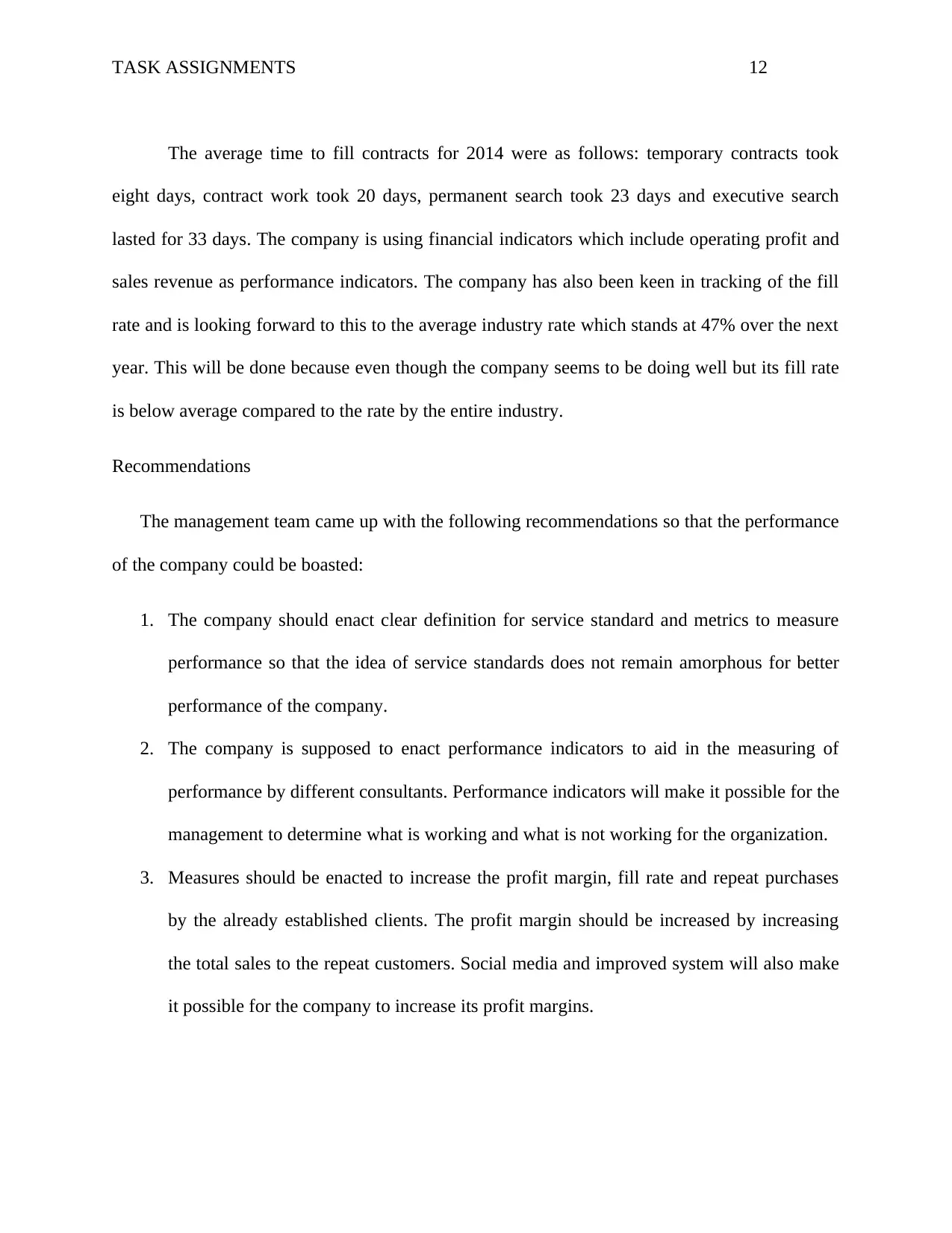
TASK ASSIGNMENTS 12
The average time to fill contracts for 2014 were as follows: temporary contracts took
eight days, contract work took 20 days, permanent search took 23 days and executive search
lasted for 33 days. The company is using financial indicators which include operating profit and
sales revenue as performance indicators. The company has also been keen in tracking of the fill
rate and is looking forward to this to the average industry rate which stands at 47% over the next
year. This will be done because even though the company seems to be doing well but its fill rate
is below average compared to the rate by the entire industry.
Recommendations
The management team came up with the following recommendations so that the performance
of the company could be boasted:
1. The company should enact clear definition for service standard and metrics to measure
performance so that the idea of service standards does not remain amorphous for better
performance of the company.
2. The company is supposed to enact performance indicators to aid in the measuring of
performance by different consultants. Performance indicators will make it possible for the
management to determine what is working and what is not working for the organization.
3. Measures should be enacted to increase the profit margin, fill rate and repeat purchases
by the already established clients. The profit margin should be increased by increasing
the total sales to the repeat customers. Social media and improved system will also make
it possible for the company to increase its profit margins.
The average time to fill contracts for 2014 were as follows: temporary contracts took
eight days, contract work took 20 days, permanent search took 23 days and executive search
lasted for 33 days. The company is using financial indicators which include operating profit and
sales revenue as performance indicators. The company has also been keen in tracking of the fill
rate and is looking forward to this to the average industry rate which stands at 47% over the next
year. This will be done because even though the company seems to be doing well but its fill rate
is below average compared to the rate by the entire industry.
Recommendations
The management team came up with the following recommendations so that the performance
of the company could be boasted:
1. The company should enact clear definition for service standard and metrics to measure
performance so that the idea of service standards does not remain amorphous for better
performance of the company.
2. The company is supposed to enact performance indicators to aid in the measuring of
performance by different consultants. Performance indicators will make it possible for the
management to determine what is working and what is not working for the organization.
3. Measures should be enacted to increase the profit margin, fill rate and repeat purchases
by the already established clients. The profit margin should be increased by increasing
the total sales to the repeat customers. Social media and improved system will also make
it possible for the company to increase its profit margins.
⊘ This is a preview!⊘
Do you want full access?
Subscribe today to unlock all pages.

Trusted by 1+ million students worldwide
1 out of 29
Related Documents
Your All-in-One AI-Powered Toolkit for Academic Success.
+13062052269
info@desklib.com
Available 24*7 on WhatsApp / Email
![[object Object]](/_next/static/media/star-bottom.7253800d.svg)
Unlock your academic potential
Copyright © 2020–2025 A2Z Services. All Rights Reserved. Developed and managed by ZUCOL.




